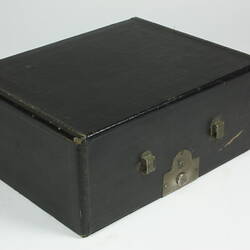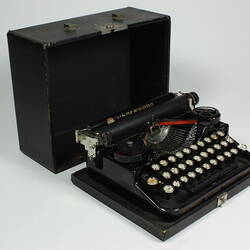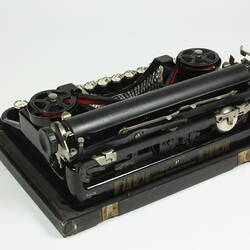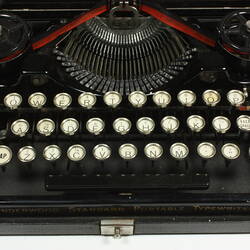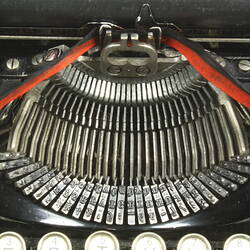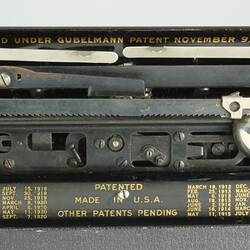Summary
Portable typewriter of the type-bar, front strike class, made by the Underwood Typewriter Company of Hartford, Connecticut, U.S.A.
The basic configuration used in Underwood typewriters was invented in 1895 by Francis Xavier Wagner. It offered the great advantage over other typewriter designs that the typebars rested in a typebasket below and in front of the platen and struck the paper and platen from the front. Thus the words being typed were clearly visible to the operator. Wagner's invention was strongly supported by John T. Underwood, a manufacturer of carbon paper, inks and typewriter ribbons, and the original Wagner Typewriter Company became the Underwood Typewriter Company.
The Underwood configuration became the standard layout for the majority of manual typewriters manufactured in the first half of the twentieth century.
Physical Description
Black metal frame resting on a wooden baseboard. Cylindrical platen. Type-bars rest in a horizontal curved type-basket in front of platen. Ink ribbon carried between two spools on vertical axes. Three-row QWERTY keyboard with 28 character keys. 'FIG' and 'CAP' keys to left of character keys, 'BACK SPACE' and 'CAP' keys to right. All keys circular, white with black lettering. Black spacebar positioned in front of keyboard. Case consisting of box fitting over typewriter baseboard, covered in black leather-like material with leather handle and metal catch.
More Information
-
Collecting Areas
-
Acquisition Information
Donation from Unknown, Before 22 Mar 1995
-
Manufacturer
Underwood Typewriter Company, Hartford, Connecticut, United States of America, 1923-1929
-
Inscriptions
On paper guide: '[Company logo] UNDERWOOD' On lower front frame: 'UNDERWOOD STANDARD PORTABLE TYPEWRITER' On back of frame below carriage: 'PATENTED / MADE IN U.S.A. / OTHER PATENTS PENDING / MARCH 19, 1912 [List of dates] MAY 22, 1923' Inscribed on catch of case: 'MADE IN U.S.A.'
-
Brand Names
-
Classification
-
Category
-
Discipline
-
Type of item
-
Overall Dimensions
315 mm (Width), 260 mm (Depth), 130 mm (Height)
Overall dimensions with cover.
-
Overall Dimensions
290 mm (Width), 230 mm (Depth), 120 mm (Height)
Overall dimensions without cover.
-
Keywords


